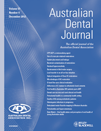A novel evaluation method for optical integration of Class IV composite restorations
Abstract
Background: This aim of this study was to compare traditional visual appreciation with spectrophotometry to evaluate the optical integration of anterior composite restorations.
Methods: Eleven restorations were evaluated in eight patients receiving dental treatment at fourth and fifth year student clinics at the dental school of the University of Geneva, Switzerland. Colour integration of completed restorations was assessed by visual observation according to USPHS criteria and spectrophotometric analysis; both methods were then compared.
Results: A mean ΔE of 1.1 (range 0.7 to 1.7) corresponded to an optimal visual integration between natural tooth and restoration (alpha score) while a mean ΔE of 3.3 (range 2.6 to 3.8) corresponded to clinically ‘non-acceptable’ visual integration (charlie score). Restorations scored as ‘bravo’, corresponded to a suboptimal but not disturbing visual integration, had a mean ΔE of 2. L* and b* values present at the bevel area and into the composite bulk tended to be lower than that of the natural tooth while a* composite values were slightly higher.
Conclusions: The spectrophotometric method employed in this pilot study has confirmed the published range of ΔE (global difference of L*a*b* values) corresponding to clinically ‘optimal’, ‘acceptable’ and ‘unacceptable’ colour integration.




